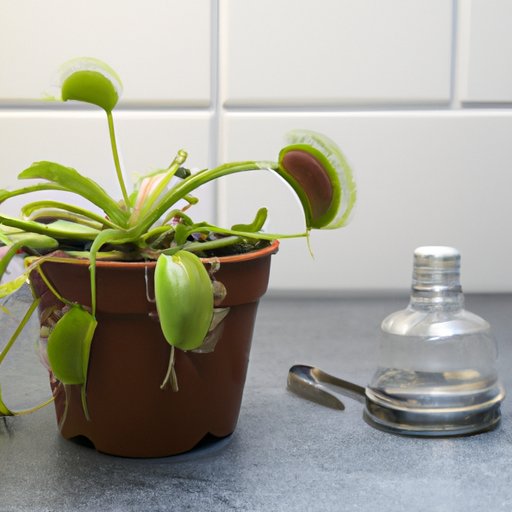Introduction
The Venus flytrap is a carnivorous plant native to subtropical wetlands on the East Coast of the United States. It has long been admired for its unique ability to capture and digest small insects, which it uses as a source of nutrition. Caring for a Venus flytrap at home can be rewarding, as these plants are relatively easy to maintain and can live for many years with the right care.
In this article, we will explore what is involved in caring for a Venus flytrap at home, including providing the plant with adequate sunlight, watering with distilled or rainwater, feeding the plant insects for nutrients, keeping the soil moist, and ensuring proper drainage in the potting container.

Provide the Plant with Adequate Sunlight
Venus flytraps require at least six hours of direct sunlight each day. They do best when placed in a sunny window that receives full sun throughout the day. If you don’t have access to a bright window, you can also place your plant outdoors for part of the day. Be sure to bring it inside before temperatures drop below freezing.
If you choose to put your Venus flytrap outdoors, make sure to place it in a shaded area that receives indirect sunlight. Direct sunlight can cause the leaves to burn, so it’s important to find a spot that receives plenty of light but is not too sunny.

Water with Distilled or Rainwater
Venus flytraps are sensitive to chlorine and other chemicals found in tap water, so it’s important to water your plant with distilled or rainwater. Distilled water can be purchased from the store, or you can collect rainwater in a container and use that. Make sure to check the pH level of the water before using it; it should be between 5.5 and 6.5.
If you don’t have access to distilled or rainwater, you can also use tap water that has been left out overnight to allow the chlorine to evaporate. It’s best to avoid using tap water if possible, as it can contain harmful chemicals that can damage your plant.
Feed the Plant Insects for Nutrients
Venus flytraps need protein in order to stay healthy, so it’s important to feed them small insects such as flies, gnats, and spiders. You should only feed your plant once every two weeks, and only give it enough food to fill one of its traps. Overfeeding can lead to root rot and other problems.
When sourcing insects for your plant, it’s important to make sure they are free of pesticides and other chemicals. You can purchase pre-packaged insects from pet stores or online, or you can collect them from your garden or local park. Make sure to wash any bugs you collect before feeding them to your plant.
Keep the Soil Moist
Venus flytraps prefer moist soil, so it’s important to keep an eye on the moisture level of the soil in your potting container. The soil should be damp but not soggy; if it’s too dry, your plant won’t be able to absorb enough water and nutrients. To check the moisture level, stick your finger into the soil and feel around; if it feels dry, it’s time to water your plant.
It’s also important to make sure your potting container has good drainage. If the soil stays too wet for too long, it can lead to root rot and other problems. Make sure to use a potting container with several drainage holes at the bottom, and consider adding a layer of gravel or stones to the bottom of the container to help improve drainage.

Ensure Proper Drainage in the Potting Container
Proper drainage is essential for keeping your Venus flytrap healthy. When choosing a potting container, make sure it has several drainage holes at the bottom and a layer of gravel or stones at the bottom. This will help ensure that excess water can drain away and the soil doesn’t become overly saturated.
It’s also important to make sure your potting container is large enough to accommodate the size of your plant. If the pot is too small, the roots won’t have enough room to spread out and your plant won’t be able to take up enough water and nutrients.
Conclusion
Caring for a Venus flytrap at home can be a rewarding experience, and with the right knowledge and care your plant can live for many years. In this article, we explored what is involved in caring for a Venus flytrap, including providing the plant with adequate sunlight, watering with distilled or rainwater, feeding the plant insects for nutrients, keeping the soil moist, and ensuring proper drainage in the potting container.
Now that you know how to properly care for a Venus flytrap, why not give it a try? With the right care and attention, you can enjoy the beauty and uniqueness of this fascinating plant for years to come.
(Note: Is this article not meeting your expectations? Do you have knowledge or insights to share? Unlock new opportunities and expand your reach by joining our authors team. Click Registration to join us and share your expertise with our readers.)
